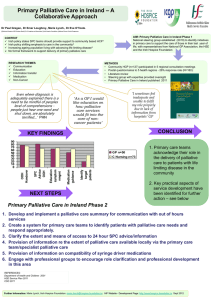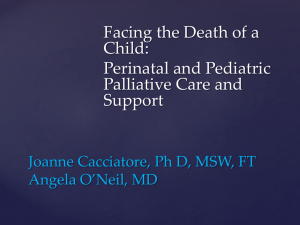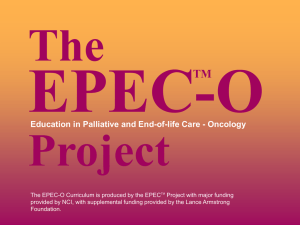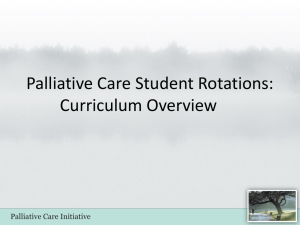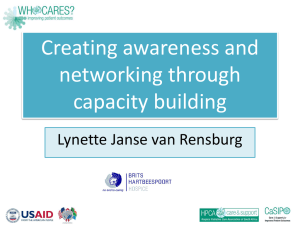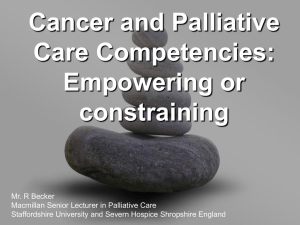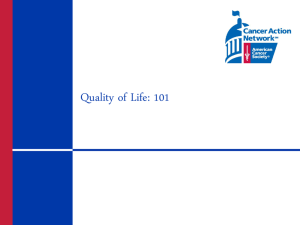Is there a Role for the Registered Psychiatric Nurse
advertisement
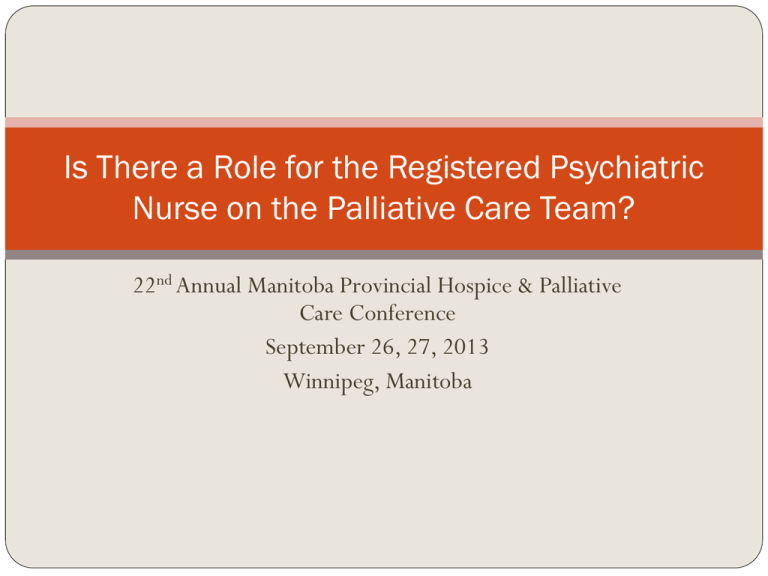
Is There a Role for the Registered Psychiatric Nurse on the Palliative Care Team? 22nd Annual Manitoba Provincial Hospice & Palliative Care Conference September 26, 27, 2013 Winnipeg, Manitoba Faculty/Presenter Disclosure Speaker: Debra Dusome R.N., B.A. (Hons.), Ex.A.T., M.A. Relationships with commercial interests: Other: Debra is an Assistant Professor in the Faculty of Health Studies at Brandon University and teaches in the Bachelor of Science in Psychiatric Nursing Program Disclosure of Commercial Support This presentation has received no financial support This presentation has received no in-kind support Potential for conflict(s) of interest: Brandon University does seek placement opportunities for their B.Sc.P.N. students Mitigating Potential Bias Although I may visit potential clinical placement sites to assess whether sites can meet student learning objectives, I do not personally arrange and negotiate student placements Student placements are arranged through the Brandon University Clinical Co-ordinators: Betty Wedgewood and Jacqueline Pentney All placements are negotiated using HSPnet and employers always have the right to accept or decline requests Learning Objectives: 1. 2. 3. 4. 5. 6. 7. Participants will learn about the Brandon University Psychiatric Nursing Curriculum Participants will learn about the skill set of Registered Psychiatric Nurses Discussion of needs of individuals with Serious Mental Illness in the Palliative Care Setting Mental Status Examination – Assessing for Depression and Suicide Risk in the Palliative Care Setting Intervention strategies to manage depression and suicidal thoughts Open dialogue about preparing students for Palliative and Hospice Care work Respond to questions from participants Curriculum – Year One Pre-Psychiatric Nursing Year Health Promotion: Developmental Transitions Throughout the Lifespan Fundamentals of Psychiatric Nursing Practice I Introduction to Interpersonal Communication Intro Psychology Intro Sociology The Sociology of Medical Systems Human Anatomy and Physiology Introduction to Statistics/Data Analysis/Fundamentals of Psychological Research/Social Research Methods Curriculum – Year Two Fundamentals of Psychiatric Nursing Practice II (Lab) Principles of Health Assessment (Lab) Psychopharmacology Fundamentals of Psychiatric Nursing Practice III (Lab) Integrated Practicum I (3 weeks) Principles of Individual Counselling (Lab) Medical Nursing for Psychiatric Nurses (Clinical 1 day/wk for the Winter Term) Psychopathology Integrated Practicum II (3 weeks) Curriculum – Year Three Psychiatric Nursing for Elderly Persons Introduction to Palliative Care Community Health (Field Work) Therapeutic Groups (Lab) Acute Mental Health Challenges I Family Counselling (Lab) Developmental Challenges (Field Work) Addictions Interpersonal Abuse Integrated Practicum III (6 weeks) Curriculum – Year Four Psychiatric Nursing with Children and Adolescents Psychiatric Rehabilitation and Recovery (Field Work) Philosophical Perspectives for Practice Introduction to Health Research Methods Leadership in Professional Practice Contemporary Perspectives on Professional Health Issues Integrative Clinical Practicum (8 weeks) Skill Sets Infection Control (includes hand hygiene, Intravenous Therapy (includes calculation of Vital Signs Oxygen Therapy Airway Management (includes inserting Wound Care (includes sterile technique, dry Mobility and Safety Hygiene Elimination (includes specimen collection, Documentation Medication Administration (all routes, personal protection gear, universal/routine precautions & practices) airways, suctioning, mouth care, tracheostomy care and tracheostomy suctioning) urinary and bowel care, ostomy care, cathether insertion, care and removal) Nutrition (includes assisted feeding with dysphagia, tube feeding and medication administration via jejunostomy or gastrostomy tubes) BU, BScPN Fundamental Psychiatric Nursing Skills Portfolio (2012) flow rates, maintenance and care of peripheral I.V’s gravity fed and via pump, regulating I.V. flow, discontinuing peripheral I.V.’s, changing solutions and tubing and discontinuing peripheral I.V.’s) dressings and packing, wound irrigation, assessment, prevention and treatment of pressure ulcers, suture and staple removal, and hydrocolloid dressings) cannot give I.V. medications as students) Health Assessment (includes full systems assessment including mental status exam and the minimental status exam to assess cognitive functioning) Blood Sugar Monitoring Post Mortem Care Introduction to Palliative Care Course Course Description This course is a 1.5 CH course that meets 1.5 hours per week for 12 weeks with a group presentation requirement. Students in this course will gain knowledge of the principles of palliative care for persons with life threatening and life-ending illnesses. Emphasis is placed on understanding within a familial context from the perspective of an interdisciplinary team. Students have the opportunity to explore their own beliefs and values about living and dying and to examine how their own experiences contribute to their professional practice role in palliative care. Course Text Zerwekh, J.V. (2006). Nursing care at the end of life: palliative care for patients and families. Philadelphia, PA:F.A. Davis. The Hospice Family Care-giving Model Zerwekh, (2006) Course Topics The Context of Palliative Care Historical Evolution of Palliative Care Sustaining Yourself as a Nurse Palliation in Severe and Persistent Mental Illness Children Facing Death Cultural Humility in Palliative Care Communication in Palliative Care Legal and Ethical Issues in Palliative Care Symptom Management (Pain) Management of Physical NonPain Symptoms Strengthening the Family Spiritual Care The Final Hours Personal Reflections and Learnings Regarding the Role of the Psychiatric Nurse in Palliative/Hospice Care W.R.H.A. Tool Kit Re: Staff Mix Identifying Potential Areas of Practice for RPN’s “At a 2009 meeting of the W.R.H.A. Nursing Leadership Council, discussions regarding the appropriate utilization of R.P.N.’s within the health care system in Winnipeg resulted in the agreement that other patient populations would benefit from the addition of a RPN to the health care team.” Tool Kit for the Introduction of Registered Psychiatric Nurses in NonIdentified Mental Health Settings – Introduction and Background, Feb. 2011. Staff Mix Decisions as to the appropriate staff mix for a particular unit, program or service and the potential benefit of introducing a RPN role are complex and need to consider a number of factors including: Needs of the patient population (for example, prevalence of mental health issues, complex family dynamics, need for psychosocial interventions and therapies. etc.) Scope of practice of the LPN, RN and RPN Scope of practice of other health care providers on the current health care team Environmental factors (for example, practice supports, consultation resources, and the stability/predictability of the environment) (CLPNM, CRNM, & CRPNM, 2010; College of Nurses of Ontario, 2009) Tool Kit Feb. 2011. Populations that are Underserved in Palliative Care People with Serious and Persistent Mental Illness People with Intellectual Disability People experiencing Dementia People with Significant Substance Abuse and Dependence Individuals who are Homeless People who are Incarcerated Baker (2005), Woods et al. (2008), Goldenberg et al. (2000), Foti, (2003), Webber (2012), Cross et al. (2012), McGraft & Jarrett (2007), Ellison (2008), Albisson & Strang (2003),Aminoff & Adunsky (2005), Diwan et al. (2004), DRC (2006), McCarron & McCallion (2007), Robinson et al. (2005), Davis & Bucknell, (2011), Hughes, (2001). Barriers to Access to Palliative Care Care provider concern that they do not have the theoretical and practical skill sets to work with these populations of individuals with specialized needs Issues related to competency re: consent for treatment, making informed decisions and designating substitute decision makers Communication issues i.e., individuals who are non-verbal or who possess limited speech, individuals who experience ongoing delusional thinking and hallucinations who are difficult to engage in conversation related to illness and/or issues of trust Behavioural issues: concerns that patients may be aggressive, elopement risks, non-compliance with treatment and odd behavioural presentations Reciprocal Stigma McCasland (2007), Cross et al. (2012), Foti (2003), Baker (2005), Woods et al. (2008), Goldenberg et al. (2000), McGrath & Jarrett (2007) Stigma During End-of-life Care “Individuals with a terminal illness in psychiatric facilities can have multiple stigmatized social identities as they are not only considered mentally ill, but are often imprisoned, aged, and have other illnesses or disabilities apart from the fact that they are also dying. The impact of multiple stigmatising social identities may affect not only the institutionalized individual with a mental illness seeking end-of-life care but also the service providers who care for them.” The Park Centre for Mental Health Study For many staff had become family – reluctance to move patients to unfamiliar settings Palliative Care Consultation – desire for more on-site support Reciprocal stigma McGraft, P. & Jarrett, V. (2007). The Problem of Stigma during End-of-life Care at a Psychiatric Institution. International Journal of Psychosocial Rehabilitation. 11 (2), 19-30. Palliative Care and the Seriously Mentally Ill Schizophrenia Bipolar Disorder Major Depression Dementia Schizoaffective Disorder Significant Substance Abuse/Dependence Personality Disorders/Complex PTSD Anorexia Nervosa Co-Occurring Disorders The Prevalence of Medical Illness in People with Mental Illness People with mental illness have high mortality and morbidity rates associated with high suicide rates, accident rates and the incidence of alcohol and drug problems This population also has high rates of unrecognized medical disorders and consequent neglect of physical problems Late diagnosis and early death is considered to be a normal statistic for people with SPMI Hahm & Segal (2005), McCasland (2007), Foti (2003),Ellison (2008), Davie (2006), McGrath et al, (2004), Goldenberg et al. (2000), Woods et al., (2008) Needs of Individuals with Serious Mental Illness in the Palliative Care Setting Engaged treatment relationship with people they know and trust as much as possible Earlier identification of medical illnesses and treatment Cross-training of palliative care and mental health care providers Involvement as much as possible in end-of-life decisions with use of both psychiatric advance directives and end-of-life medical care advance directives Education, care, support, assistance, and bereavement counselling by providers who value collaboration, advocacy and research Access to compassionate end-of life care in a variety of settings (ideally involving client choice) Woods et al. (2008), Baker, (2005),Goldenberg et al. (2000), Tate & Longo (2005), Foti (2003), Webber (2012) Serious Mental Illness and the Capacity to Make Decisions Regarding End-of-Life Care “Do It Your Way” : A Demonstration Project on End-of-Life Care for Persons with Serious Mental Illness – Foti, M. E. (2003) End of Life Care for People with Mental Illness – Inner City Health Associates, Toronto, Mission Hospice Program, Ottawa Inner City Health, Florida, U.S.A. “Just-Do-It” approach – Webber, T. (2012) Service Delivery Settings for Individuals with Serious and Persistent Mental Illness Hospice/Palliative Care Units Long Term Care Units in Psychiatric Institutions Long Term Care Units In Nursing Home, PCH Settings Psychiatric Rehabilitation Group Homes Own Homes with Intensive Psychiatric Support & Palliative Home Care Support Home of Family Members or Significant Others Combination Medical/Psychiatric Units On the Street (Shelter and Mobile Services) **Majority of research does not support palliative care delivery on acute psychiatric units Baker (2005), Davie (2006), Foti (2003),Goldenberg et al. (2000), Hughes (2001), McCasland (2007), Woods et al. (2008), Webber (2012) Recommended Reading Bartok, Mira, (2011). The Memory Palace. Free Press, Simon & Schuster, Inc., New York: N.Y. Depression Experienced by Individuals Receiving Palliative Care Depression is common in hospice and palliative care settings with prevalence ranges of 1% - 42% and 0% - 58% in patients with cancer, a rate 4x’s that of the general population, other studies have rates of 25% - 50% Under recognition leads to under treatment and unwanted outcomes Depression can interfere with an individual’s capacity to understand his/her situation, make decisions, interact with caregivers and to reach final goals Those with depression have increased illness severity and pain and depression increases the risk of suicide Irwin et al. (2008), McCabe et al. (2012) Mental Status Assessment General Description Perceptual Disturbances: including Attention Span: digit repetition forward and backward Orientation: time, place, person Memory: good, fair, poor Fund of Knowledge: good, fair, poor Judgment: good, fair, poor Insight: good, fair, poor Thought Processes: including conceptual ability, organization, speed/flow, content, delusional ideations, preoccupations, affect, and mood hallucinations; auditory, visual, gustatory, olfactory, tactile and command, illusions, déjà vu, depersonalization, and derealization Motor Activity Disturbances: agitation, catatonia, tremors, mannerisms, retardation, stereotypy Coping/Stress Tolerance: identification of current stressors and coping skills and strategies Aggression Potential: high, moderate, or low Suicide/Lethality: high moderate or low Summary of Mental Status Mini-Mental Status Examination: Assess cognitive functioning Assessing for Depression and Suicide Risk in Palliative Care Explore DSM-IV-TR criteria for depression i.e. at least 2 weeks depressed mood or loss of interest and at least four additional symptoms of depression; changes in appetite or weight, sleep, and psychomotor activity, decreased energy, feelings of worthlessness or guilt, difficulty thinking and concentrating or making decisions, recurrent thoughts of death or suicidal ideation, plans or attempts to commit suicide. The symptoms must be different from person’s pre-morbid state and must persist for most of the day, every day for at least two weeks. In Palliative Care recognize that somatic symptoms are less reliable as they often overlap with symptoms related to terminal illness Use of instruments to measure levels of depression Suicide Risk and Lethality Assessment Are there current thoughts of suicide? How often do these thoughts occur? Assess for feelings of hopelessness, helplessness, worthlessness and guilt. Does the individual feel they are a burden to others? Does the individual have a plan? How detailed is the plan? Has the person made plans to avoid discovery? Is the individual seeking death or a relief from suffering? Does the individual have the means to complete the plan? How lethal is the methodology i.e. use of guns, hanging, jumping, CO2 poisoning, drug overdose, cutting, deliberate car accident ? Does the individual have a past history of suicide attempts and/or history of previous depression? What happened related to past attempts? Does the individual have access to drugs and/or alcohol and are they regularly under the influence of these substances? Has a significant other successfully completed suicide? Is there anything that prevents individual from acting on thoughts i.e. doesn’t want to hurt loved ones, religious beliefs, stigma associated with suicide, loss of insurance for family? Suicide Risk and Lethality Assessment (cont.) Is there estrangement or family conflict? Does the individual fear abandonment by significant others or care-givers due to increased level of dependence and care required? Is the individual experiencing pain and/or other illness symptomatology that is untenable and/or frightening i.e. nausea, failing cognition, air hunger, terminal restlessness, loss of bowel and bladder control, ability to swallow? Does the individual feel their life no longer has dignity? How does the individual imagine his last days or hours? Are these perceptions accurate? Is the person experiencing a loss of a sense of self? Is the individual frightened of dying and the letting go of control? Do they fear retribution for past sins or transgressions? Is the person angry and if so what is the anger related to? Is there the potential for aggressive behaviours towards self and others? LISTEN, LISTEN, LISTEN Intervention Strategies to Manage Depression and Suicidal Thoughts Identify if individual is at significant risk of harming self or others and inform treatment team so that additional support and observation can be given in addition to developing safety plans for individual and others – referral for psychiatric consultation Does assessment indicate underlying depression that may respond to treatment – if yes – referral for psychiatric consultation If individual has detailed plan and means – remove means if possible Address suffering – Ask individual what they think might help and assist with suggested interventions Work on affirming life affirming beliefs and values Address family estrangement and conflict if possible and individual is supportive of this intervention Intervention Strategies to Manage Depression and Suicidal Thoughts (cont.) Address fears of abandonment and feelings about loss of control and increased dependency Allow as much room for autonomy and choice in making end of life decisions – act as an advocate for the individual with the treatment team and significant others Provide options i.e. referral to spiritual care, Dignity Therapy, involvement in preparatory bereavement groups, an opportunity to express self through the arts, ongoing 1:1 engagement or counselling to facilitate expression of feelings and to let individual know they are not alone, visits from Artists in Healthcare, palliative care volunteers, opportunities for sharing life review with others Provide positive outlets for the expression of angry feelings Assist and support in the saying goodbye process Intervention Strategies to Manage Depression and Suicidal Thoughts (cont.) Talk about fears of dying for clarification of what individual concerns are Provide education re: what will be experienced in the last weeks, days and hours and indicate what comfort measures can be provided If medication is ordered, administer as ordered and provide psycho-education re: expected effects, possible side effects and monitor individual response to treatment and maintain ongoing 1:1 engagement – treat individual as collaborative partner in care Distinguishing Depression from Preparatory Grief Depression Preparatory Grief Appetite & weight changes, fatigue, low energy, sleep disturbances & sexual dysfunction Persistent flat affect Negative self-image Anhedonia Hopelessness, tearfulness Prolonged social withdrawal Ongoing persistent agitation Active desire for early death, suicidal ideation and plans Decreased ability to concentrate and make decisions Appetite & weight changes, fatigue, low energy, sleep disturbances & sexual dysfunction Mourning the multiple losses associated with dying Intense grieving that comes in waves, temporary social withdrawal Grieving individuals usually maintain a normal sense of self-esteem Still experience pleasure in connecting with others and look forward to special events Maintain a sense of hope Desire for continuing social interaction Periyakoii & Hallenbeck (2002), Axtell, (2008), Noorani & Montagnini (2007) Intervention Strategies to Manage Anxiety in the Palliative Care Setting Spend 1:1 time with individual to explore anxiety i.e. fears, specific triggers, past history of anxiety, previous treatment interventions – which ones worked Explore previous coping strategies for managing anxiety and support individual to use effective interventions Teach self-soothing , grounding strategies, mindfulness-based stress reduction techniques, relaxation therapy, meditation, use of music, lullabyes, singing Address specific fears and concerns similar to interventions on previous slides i.e. are they specifically related to the dying process? Assess whether anxiety is related to loved ones left behind re: emotional, financial security etc. these may be very valid fears – assist to plan for care of loved ones – referral to social worker on team Possible psychiatric consultation and medication assistance – administer and monitor effectiveness of medication – provide education to individual about medication – act as a collaborative partner in care Ideological Interface of Palliative Care and Psychiatric/Mental Health Care McGrath, P. & Holewa, H. (2004) Person-centered practice Relationship-based connectedness Belief in compassionate, holistic care Respect for autonomy and choice Quality of Life issues Family as the unit of care Need for democratic multidisciplinary team work – flat structure Need of special personality attributes for staff Similarities Between Psychiatric Nursing and Palliative Care Nursing Cutcliffe, J. R. et al. (2001) Psychiatric Nursing Palliative Care Nursing Holistic, biopsychosocial and Holistic, biopsychosocial and spiritual spiritual approach Recovery oriented focusing on best QOL i.e. finding a meaningful life path in spite of chronic illness – focus on care VS cure Focus on psychosocial, emotional needs Primacy of the nurse/client relationship and therapeutic use of self Support individual autonomy and decision making approach Active total care of patients whose disease is not responsive to curative treatment Focus on symptom control and management enabling best QOL and meaningful experience until death Focus on psychosocial, emotional needs Relationship is one of the essential tenets of care Support individual autonomy and decision making Similarities Between Psychiatric Nursing and Palliative Care Nursing (cont.) Cutcliffe, J. R. et al. (2001) Psychiatric Nursing Connecting with individuals who are distressed and suffering Focus on ‘being with’ rather than ‘doing for’ Primacy of providing non-physical psychosocial support True ‘presence’ with individual and family required Use of intuitive knowing Focus on the phenomenological understanding of the person and their world Collaborative relationship in which care is negotiated Palliative Care Nursing Connecting with individuals who are distressed and suffering Focus on ‘being with’ rather than ‘doing for’ Primacy of providing both physical and non-physical psychosocial support True ‘presence’ with individual and family required Use of intuitive knowing Focus on the phenomenological understanding of the person and their world Collaborative relationship in which care is negotiated Dignity Therapy and Recovery Narrative Psychiatric Nursing Skills Sets Related to Palliative Care Strengths Areas for Further Development Communication and counselling Increased knowledge re: pain skills for individuals, families and groups Specialist knowledge re: mental illness, developmental challenges, addictions, forensic nursing, addictions, interpersonal abuse and psychosocial rehabilitation and recovery management and pharmacological interventions in palliative care Increased knowledge re: lifethreatening and life–ending illnesses Dialogue Questions ??? References A Reference Sheet Handout will be available to all participants.
